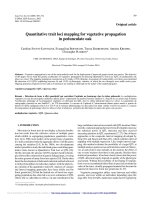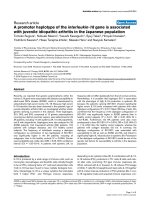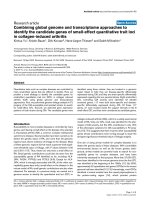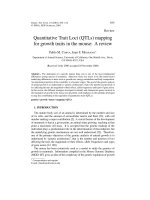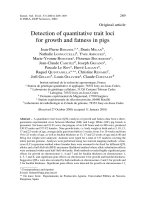Mapping of quantitative trait loci (QTLS) associated with sugarcane aphids resistance in recombinant inbreed population of sorghum [Sorghum bicolor (L.) Moench]
Bạn đang xem bản rút gọn của tài liệu. Xem và tải ngay bản đầy đủ của tài liệu tại đây (278.05 KB, 10 trang )
Int.J.Curr.Microbiol.App.Sci (2019) 8(3): 2593-2602
International Journal of Current Microbiology and Applied Sciences
ISSN: 2319-7706 Volume 8 Number 03 (2019)
Journal homepage:
Original Research Article
/>
Mapping of Quantitative Trait Loci (QTLs) Associated with Sugarcane
Aphids Resistance in Recombinant Inbreed Population of
Sorghum [Sorghum bicolor (L.) Moench]
S.P. Mehtre1*, C.T. Hash2, H.C. Sharma2, S.P. Deshpande2 and G.W. Narkhede1,2*
1
Vasantrao Naik Marathwada Krishi Vidyapeeth, Parbhani 431 402 (MS) India
2
International Crops Research Institute for the Semi-Arid Tropics (ICRISAT),
Patancheru, 502324, Telangana India
*Corresponding author
ABSTRACT
Keywords
Sorghum, Aphid
Resistance,
Quantitative Trial
Loci (QTL)
Article Info
Accepted:
26 February 2019
Available Online:
10 March 2019
Mapping of QTL associated with sorghum aphid resistance was undertaken in a
recombinant inbred population derived from 296B (susceptible) x IS 18551 (Resistance)
parents. Totally 2 QTLs spread across linkage group were detected at threshold LOD of
2.50. The alleles of IS 18551 contributed to increase aphid tolerance. QTL analysis across
season revealed that QTL mapped on LG ‘J’ was a major one, explaining 20.4% of the
observed phenotypic variance with a peak LOD value 9.2 and showed nonsignificant Q x
E interaction. This major QTL flanked by two linked markers i.e. Xtxp 15 - Xtxp 283 and it
will be targeted for marker-assisted selection in a practical breeding program aiming at
increasing the level of resistance in agronomically elite backgrounds through gene
pyramiding for aphid resistance.
Introduction
Sorghum is the fifth most important cereal
crop globally after rice, maize, wheat, and
barley. It is grown in about 86 countries
covering an area about 47 million hectares
(ha) with a grain production of 69 million ton
and average productivity of 1.96t/ha
(ICRISAT, 1996; FAO, 2004). India is a
major producer of sorghum with the crop
occupying an area of 9.9 million ha and
yielding an annual production of 8.0 million
ton during 2003-04 (FAS, 2005). The
productivity of sorghum is highly variable
from country to country. Several constraints
affect grain productivity. Among these
drought and pests are the predominant ones.
Sugarcane aphid (Melanaphis sacchari)
prefers to feed on the under the surface of
older leaves. The damage proceeds from the
lower to upper leaves. The nymph and adults
suck sap from the lower surface of leaves, and
this leads to stunted plant growth. The damage
is more serve in crops under drought stress
and results in drying up of leaves and plant
mortality. The insects’ population increases
rapidly at the end of the rainy season during
2593
Int.J.Curr.Microbiol.App.Sci (2019) 8(3): 2593-2602
dry spells. Its infestation is high during the
post-rainy season in India and aphid
infestation spoils the crop fodder quality
(Waghmare et al., 1995).
In addition to the temperature, cloudy weather
together with increasing humidity can result in
aphid colonies completely covering the
abaxial surface of all leaves of sorghum plants
(Mote 1983). Aphid density was greater under
irrigation than in rainfed conditions and its
occurrence on sorghum at milk stage,
deteriorated fodder quality (Balikai, 2001).
Sorghum grain and fodder yield losses ranging
from minor to severe have been reported in
India (Mote and Kadam, 1984; Mote et al.,
1985). In Sorghum, the losses varied between
12-26 and 10-31% with an overall loss of 16
% and 15 % for grain and fodder yield,
respectively (Balikai, 2001).
The selection of sorghum genotypes for
resistance to aphids by utilizing one or few
resistance parameters is inefficient because
several components are involved in resistance
and one or more genes govern each of these
resistance components.
Further, expression of many of these
components is influenced by environmental
variation; hence aphid resistance is a
quantitative trait and shows a large amount of
genotype x environmental interaction. Markerassisted selection has considerable potential to
improve the efficiency of selection for
quantitative traits (Hash and Bamel Cox,
2000).
In the present investigation we tried to map
aphid resistance QTLs, the ultimate goal of
such QTL analysis is to develop tools that are
useful for marker-assisted selection in a
practical breeding programme aiming at
increasing the level of resistance in the
agronomically elite background through gene
pyramiding for aphid resistance.
Materials and Methods
The experiment consisted of a set of 213
recombinant inbred lines (RILs) (F 7:8) derived
from a cross between two sorghum inbred
lines viz. 296B (susceptible to aphid) and IS
18551 (tolerance to aphid). The RIL
population progenies along with both parents
were used for phenotyping and genotyping.
The RILs were produced at ICRISAT,
Patancheru. After the initial cross between
296B and IS 18551, a single F1 plant was
selfed. The resulting F2 seeds were sown and
F2 plants were selfed. The F3 seeds were sown
head-to-row, each F3 plant was selfed and
from each head-to-row, a single plant was
randomly chosen to provide the seeds for the
next generation, and this was repeated for 3 to
4 generations, up to F7. The bulk seed was
harvested from randomly selected F6 plants to
produce 213 F7 recombinant inbred lines
(RILs).
Evaluation of RILs for resistance to Aphids
Screening of the RIL for Aphid resistance was
carried out at ICRISAT, Patancheru. A total of
254 lines (213 RILs +14 times repeated check
of each of 296B and IS 18551 and a standard
check, CSH 9 repeated 13 times), were sown
on 16th August, during the 2002 kharif season
(E1). For early rabi season (E2), a total of 224
entries (213 RILs + 4 times repeated checks of
each of 296B and IS18551) + standard check
CSH 9 repeated 3 times were sown on 16th
October 2004. The test material was planted in
balanced alpha design with 75 cm and 10 cm
inter and intra row spacing respectively. In the
late kharif and rabi seasons, each entry was
grown in two-row plots of 2 m length in four
and three replications respectively. Aphid
damage was evaluated at crop maturity on 1 to
9 scale, where 1= aphid present with no
apparent damage to the leaves and 9 = heavy
aphid density on infested leaves.
2594
Int.J.Curr.Microbiol.App.Sci (2019) 8(3): 2593-2602
Genotyping 213 RILs of 296B x IS 18551
mapping populations using 114 SSR markers
The genetic linkage map has been constructed
using map marker / exp 3.0 with the LOD
threshold value at 3.0 and linkage distance
(cm units) calculated using the Haldane (1919)
mapping function. Markers were mapped in
10 linkage groups with a total map length of
2165.8 cm.
QTL analysis
A total number of 213 RIL progenies from the
cross 296B x IS 18551 were used for markertrait associations. The BLUPS of these 213
RILS were used for QTL analyses. QTL
analyses were performed by using composite
interval mapping (CIM) (Jansen and Stam
1994; Zeng 1994). Required computations
were performed using Plab QTL version 1.1
(Utz and Melchinger 2000), which performs
CIM by employing interval mapping using a
regression approach (Haley and Knott, 1992)
with selected markers as cofactors. The
presence of a putative QTL, in an interval, was
tested using the Bonferroni X2 approximation
(Zeng 1994) corresponding to a genome-wise
type I error of 0.25. Since the mapping
population used in the present study was
constituted of RILs, the additive model ‘AA’
was employed for analyses in which additive x
additive epistatic effects were included. The
point at which the LOD score had the
maximum value in the interval was taken as
the estimated QTL position. QTLs detected in
different environments were treated as
common if their estimated position were
within 20 cm of each other and their estimated
effects had an identical sign. QTL x
environments interaction was analyzed over
all three environments as described by Utz and
Melchinger (2000). The proportion of genetic
variance explained by the QTL was adjusted
for QTL x environment interactions to avoid
overestimation. After the QTL analysis with
Plab QTL, the QTLs identified for
components of resistance were assigned to the
linkage group based on linkage position of
markers on the linkage map developed by
Bhattramakki et al., (2000).
Results and Discussion
The phenotypic data from two screening
environments and genotypic data for 213 RILs
were subjected to QTL analysis. The results of
this RIL analysis for aphid resistance
presented (Table 1, Fig. 1). Two aphid
resistance QTLs were detected based on
phenotypic evaluation in the kharif screening
environment and one QTL was detected based
on rabi screening environment. One of the
QTLs detected mapped on the same position
of LG ‘J’ (Linkage group J), for both
screening environment and one QTL mapped
to LG ‘E’ based on kharif (E1) screening.
The two QTLs together explained 31.5% of
the observed phenotypic variance for this trait
in kharif screening. Final simultaneous
analysis revealed that 22.7% of the adjusted
phenotypic variance was explained by these
two QTLs which had combined peak LOD
score of 12.7%. The single QTL detected in
Rabi screening explained 10.4% of the
observed phenotypic variance, the final
simultaneous fit analysis revealed that only
6% of the adjusted phenotypic variance was
explained by this single QTL with a peak
LOD score of 3.26. A favorable additive
genetic effect for low aphid incidence was
contributed by alleles from aphid tolerant
parent IS 18551 in both screening
environments. A major QTL for aphid
resistance was mapped on LG ‘J’ in the
marker interval Xtxp15 – Xtxp283.
QTL analysis across season revealed that two
aphid resistance QTLs were detected in the
across seasons. These mapped on LG ‘E’ and
LG ‘J’.
2595
Int.J.Curr.Microbiol.App.Sci (2019) 8(3): 2593-2602
Table.1 Characteristics of QTLs associated with aphid resistance in two screening environments Kharif, Rabi and across seasons
based on composite interval mapping (PLAB QTL, LOD 2.5) using RIL population derived from 296B x IS 18551
Environment / Trait
Aphid damage score
Kharif, Patancheru (E1)
Peak LOD
R2
Xtxp40 – Xtxp159
Superior
Interval (cm)
22-46
6.94
Xtxp15 – Xtxp283
140-160
7.70
Linkage
group
E
Position
Marker Interval
34
J
150
Sum: 2 QTLs
J
144
LOD = 12.73
Xtxp15 – Xtxp283
132-156
4.47
Sum: 1 QTL
17.2
- 0.349
--
Adj. R2 = 22.7%
10.4
- 0.229
--
10.4
Final Simultaneous fit
Across season (Averages)
GxE
interaction
--
31.5
Final Simultaneous fit
Rabi Patancheru (E2)
14.3
Effect
(Additive)
- 0.392
LOD = 3.26
Adj. R2 = 6.0%
E
40
Xtxp40 – Xtxp159
18-64
2.58
5.5
- 0.191
**
J
148
Xtxp15 – Xtxp283
138-156
9.26
20.4
- 0.312
NS
Sum: 2 QTLs
25.9
Final Simultaneous fit
LOD = 10.35
2596
Adj. R2 = 18.6%
Int.J.Curr.Microbiol.App.Sci (2019) 8(3): 2593-2602
Figure.1 QTL position of sugar cane aphid resistance for 213 recombinant inbred populations derived from cross 296B IS 18551
across two screening environments at Patancheru, during 2002-2004
0.0
9.9
13.2
Xtxp316
Xtxp248
Xtxp319
50.4
Xtxp75 Xgap57
83.5
Xtxp37
104.1
114.4
Xtxp32
Xtxp88 Xtxp149
0.0
54.8
Xtxp302
XSbAGH04 Xcup64
Xtxp96
0.0
22.5
25.7
33.8
41.7
46.5
123.7
192.7
200.7
Xtxp04 Xisp346
Xisp366
Xtxp298
XSbAGB03
273.9
276.9
333.5
Xtxp286
Xgap206
0.0
11.1
22.9
Xcup48
Xcup05
Xcup23
DSegmentII
0.0
Xtxp177
Xtxp114 Xisp260
Xisp251
Xtxp218
Xtxp50 Xtxp211
Xtxp304
Xtxp01 Xisp336
Xtxp348 Xtxp56
Xisp200
Xtxp207 Xtxp07
Xcup26 Xcup40
263.1
DSegmentI
Xisp323
Xcup32
Xtxp69
Xtxp34
Xtxp38 Xisp361
Xisp332 Xtxp285
100.0
237.1
300.9
Xtxp25
85.7
184.6
191.8
C
B
A
152.9
Xtxp31
172.6
Xtxp205
Xisp207
Xisp331
Xtxp228
Xcup11
298.0
315.0
323.3
330.7
2597
114.6
Xcup49
255.0
Xisp335 Xtxp12
Xtxp343
296.0
300.9
310.0
Xisp343
Xisp312
Xtxp24 Xtxp41
385.9
Xtxp27
Int.J.Curr.Microbiol.App.Sci (2019) 8(3): 2593-2602
Figure.1 QTL position of sugar cane aphid resistance for 213 recombinant inbred population derived from cross 296B IS 18551
across two screening environments at Patancheru, during 2002-2004.
G
E
0.0
12.3
Xisp348
Xtxp40 Xtxp36
57.0
64.9
77.0
Xtxp159
Xtxp312
Xisp233
110.3
0.0
A
p
h
I
d
I
0.0
2.4
5.0
10.8
16.6
21.4
33.2
43.9
61.9
67.4
Xtxp20
19.5
28.2
Xisp321
Xisp359 Xtxp331
66.2
78.6
Xisp342
Xgap01
H
Xtxp227 Xisp206
Xisp310
125.7
Xcup67 Xisp272
184.0
Xcup73
0.0
Xtxp47
F
Xtxp145
Xcup36
Xtxp317
Xtxp219
Xisp328
Xisp264
Xcup12
Xcup17
Xtxp17
Xisp347
Pl
ht
G
rY
i
J
0.0
35.8
0.0
12.9
Xtxp10
Xisp318
31.4
44.2
Xtxp230
Xtxp67
84.9
98.0
117.9
125.4
134.3
204.6
2598
XSbAGD02
Xtxp294 Xtxp292
Xtxp354
Xisp320
Xtxp18
Xtxp250
Xisp215
Xisp258Xtxp65
113.9
Xtxp23
137.8
Xtxp15
167.9
Xtxp283
A
p
hi
d
Int.J.Curr.Microbiol.App.Sci (2019) 8(3): 2593-2602
Figure.1 QTL positions of shoot fly resistance component traits for 213 recombinant inbred population derived from cross 296B IS
18551 under two screening environments, late kharif (indicated by purple color) and rabi (indicated by pink color) at Patancheru
during 2002-2004.
B
A
0.0
9.9
13.2
Xtxp316
Xtxp248
Xtxp319
50.4
Xtxp75 Xgap57
83.5
Xtxp37
104.1
114.4
Xtxp32
Xtxp88 Xtxp149
0.0
54.8
Xtxp302
123.7
192.7
200.7
XSbAGH04 Xcup64
Xtxp96
Xtxp50 Xtxp211
Xtxp304
Xtxp04 Xisp346
Xisp366
Xtxp298
XSbAGB03
273.9
276.9
Xtxp01 Xisp336
Xtxp348 Xtxp56
Xisp200
Xtxp207 Xtxp07
Xcup26 Xcup40
333.5
Xtxp286
237.1
263.1
300.9
Xtxp25
0.0
22.5
25.7
33.8
41.7
46.5
Xgap206
DSegmentI
Xcup48
0.0
Xisp323
Xcup32
Xtxp69
Xtxp34
Xtxp38 Xisp361
Xisp332 Xtxp285
100.0
Xtxp114 Xisp260
Xisp251
Xtxp218
152.9
Xtxp31
172.6
Xtxp205
85.7
184.6
191.8
C
298.0
315.0
323.3
330.7
Xisp207
Xisp331
Xtxp228
Xcup11
2599
11.1
22.9
Xcup05
Xcup23
DSegmentII
0.0
Xtxp177
114.6
Xcup49
255.0
Xisp335 Xtxp12
Xtxp343
296.0
300.9
310.0
Xisp343
Xisp312
Xtxp24 Xtxp41
385.9
Xtxp27
Int.J.Curr.Microbiol.App.Sci (2019) 8(3): 2593-2602
Figure.1 QTL positions of shoot fly resistance component traits for 213 recombinant inbred population derived from cross 296B IS
18551 under two screening environments, late kharif (indicated by purple color) and rabi (indicated by pink color) at Patancheru
during 2002-2004
E
G
0.0
12.3
Xisp348
Xtxp40 Xtxp36
57.0
64.9
77.0
Xtxp159
Xtxp312
Xisp233
110.3
123.0
A
p
hi
d
Xtxp227
Xisp310 Xisp206
Xgap342
I
0.0
19.5
28.2
Xtxp20
Xisp321
Xisp359 Xtxp331
66.2
78.6
Xisp342
Xgap01
125.7
Xcup67 Xisp272
184.0
Xcup73
F
Xtxp10
Xisp318
31.4
44.2
Xtxp230
Xtxp67
Xtxp145
Xcup36
Xtxp317
Xtxp219
Xisp328
Xisp264
Xcup12
Xcup17
Xtxp17
Xisp347
H
0.0
0.0
12.9
0.0
2.4
5.0
10.8
16.6
21.4
33.2
43.9
61.9
67.4
J
Xtxp47
0.0
35.8
84.9
98.0
117.9
125.4
134.3
204.6
2600
XSbAGD02
Xtxp294 Xtxp292
Xtxp354
Xisp320
Xtxp18
Xtxp250
Xisp215
Xisp258 Xtxp65
113.9
Xtxp23
137.8
Xtxp15
167.9
Xtxp283
A
p
hi
d
A
p
hi
d
Int.J.Curr.Microbiol.App.Sci (2019) 8(3): 2593-2602
Final simultaneous fit analysis these two
QTLs together explained only 18.6% of the
adjusted phenotypic variance in polled RIL
means with peak LOD value of 10.35%. In
across season QTL analysis, the QTL mapped
on LG ‘J’ was a major one; explaining 20.4%
of the observed phenotypic variance with a
peak LOD value 9.26. The QTL mapped on
LG ‘E’ exhibited significant Q x E interaction
while the QTL mapped on LG ‘J’ showed
non-significance Q x E interaction. The
favorable additive genetic effects for these
two QTLs were contributed by alleles from
aphid tolerant parent IS 18551.
References
Balikai, R.A., 2001. Bioecology and
management of the sorghum aphid,
Melanaphis sacchari. Ph.D. Thesis,
University of Agricultural Sciences,
Dharwad, Karnataka, India, 203pp.
Bhattramakki, D., J. Dong, A.K. Chhabra and
G.E. Hart. 2000. An integrated SSR
and RFLP linkage map of Sorghum
bicolor (L.) Moench. Genome, 43:
988-1002.
FAOSTAT. 2004. />htm
FAS. 2005. FAS Online.
United
States
Department
of
Agriculture, Foreign Agricultural
Service.
Haldane, J.B.S. 1919. The combination of
linkage values and the calculation of
distance between the loci of linked
factors. J. Genet. 8: 299-309.
Haley, C.S. and S.A. Knott. 1992. A simple
regression method for mapping
quantitative trait loci in the line
crosses using flanking markers.
Heredity, 69: 315-324.
Hash, C.T. and P. Bramel-Cox. 2000. Survey
of molecular marker applications. In
Application of Molecular Markers in
Plant Breeding. (Ed. Haussmann,
B.I.G., H.H. Geiger, D.E. Hess, C.T.
Hash and P. Bramel-Cox). Training
manual for seminar held at IITA,
Ibadan, Nigeria, 16-17 August 1999.
International Crops Research Institute
for
the
Semi-Arid
Tropics,
Patancheru, India, pp. 3-12.
International Crops Research Institute for the
Semi-Arid Tropics (ICRISAT). 1996.
The world sorghum and millet
economies: Facts, trends and outlook.
Rome, Italy: Food and Agricultural
Organization of the United Nations
(FAO), and Patancheru, A.P. 502 324,
India: International Crops Research
Institute for the Semi-arid Tropics
(ICRISAT). 72 pp.
Jansen, R.C. and P. Stam. 1994. Highresolution quantitative traits into
multiple loci via interval mapping.
Genetics, 136: 1447-1455.
Mote, U.N. 1983. Epidemics of delphacids
and aphids on winter sorghum.
Sorghum Newsl. 26, 76.
Mote, U. N., Kadam, J.R. 1984. Incidence of
(Aphis sacchari Zehnt) in relation to
sorghum plant characters. Sorghum
Newsl. 27, 86.
Mote, U.N., J.R. Kadam and D.R. Bapat.
1985. Recovery resistance to shoot fly
in some sorghum hybrids. J.
Maharashtra Agric. Univ. 10: 190193.
Mote, U.N., Shinde, M.D., Bapat, D.R. 1985.
Screening of sorghum collections for
resistance to aphids and oily maLODy
of winter sorghum. Sorghum Newsl.
28, 13.
Utz, H.F. and A.E. Melchinger. 2000.
PLABQTL: A computer program to
map QTL (version 1.1). Institute für
Pflanzenzüchtung, Saatgutforschung
und Populationsgenetik, Universitaet
Hohenheim,
D-70593
Stuttgart,
Germany.
Waghmare, A.G., Varshneya, M.C., Khandge,
2601
Int.J.Curr.Microbiol.App.Sci (2019) 8(3): 2593-2602
S.V., Thakur, S.S., Jadhav, A.S., 1985.
Effects of meteorological parameters
on the incidence of aphids on
sorghum. J. Mah. Agric. Univ. 20,
307-308.
Zeng, Z.B. 1994. Precision mapping of
quantitative trait loci. Genetics, 136:
1457-1468.
How to cite this article:
Mehtre, S.P., C.T. Hash, H.C. Sharma, S.P. Deshpande and Narkhede, G.W. 2019. Mapping of
Quantitative Trait Loci (QTLs) Associated with Sugarcane Aphids Resistance in Recombinant
Inbreed Population of Sorghum [Sorghum bicolor (L.) Moench]. Int.J.Curr.Microbiol.App.Sci.
8(03): 2593-2602. doi: />
2602
